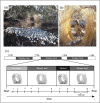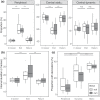Male-male associations in spotted bowerbirds (Ptilonorhynchus maculatus) exhibit attributes of courtship coalitions
- PMID: 35818498
- PMCID: PMC9262789
- DOI: 10.1007/s00265-022-03200-x
Male-male associations in spotted bowerbirds (Ptilonorhynchus maculatus) exhibit attributes of courtship coalitions
Abstract
Abstract: Despite strong selective pressures inherent in competition for mates, in species with non-resource-based mating systems males commonly engage in non-agonistic interactions with same-sex visitors at display arenas. Bowerbirds perform courtship dances on elaborate display structures - known as bowers - that are built and defended by one resident male. Several reports have suggested that bower owners tolerate the presence of specific male visitors at their display arenas, referred to here as 'subordinates'. Subordinate males may learn the skills required for successful sexual signalling via prolonged social interactions at adults' arenas, but little is known about whether courtship proficiency changes with experience and/or whether subordinates actively contribute to enhancing the resident male's mating success. In this study, we investigated male-male associations in wild spotted bowerbirds (Ptilonorhynchus maculatus). We first sought to determine whether courtship behaviour differs based on bower ownership status. We then examined whether social interactions between bower owners and subordinate males may qualify as courtship coalitions. Our analysis of courtship postural components did not reveal differences in timing or relative occurrence of postural components between subordinate males and bower owners, whereas we found evidence that male-male associations in spotted bowerbirds may provide an example of rudimentary courtship coalitions. In particular, higher subordinate attendance is associated with lower destruction rates by neighbouring rivals and with overall higher mating success, and male pairs are stable in subsequent years. This study provides novel information about social dynamics among male bowerbirds, and further insights into the evolution of coalitionary behaviour in male displays.
Significance statement: Same-sex associations between established males and subordinate visitors on display arenas are common in birds, yet poorly understood. Using video recordings from a population of wild spotted bowerbirds, Ptilonorhynchus maculatus, we performed a quantitative analysis on motor courtship components across males, and on their social interactions on display arenas to investigate the nature of male-male partnerships. Our results showed that motor courtship performance in subordinate visitors is not suggestive of an early ontogenetic stage, as previously speculated. Moreover, though bower 'owners' and subordinate males do not coordinate their behaviour during courtship or bower building, male-male partnerships may qualify as a rudimentary or incipient form of courtship coalitions. Subordinate males are tolerated at bowers, the magnitude of subordinate attendance correlates with owner males' mating success, and repeated interactions between individuals reveal consistent partner associations.
Supplementary information: The online version contains supplementary material available at 10.1007/s00265-022-03200-x.
Keywords: Coalitions; Courtship behaviour; Courtship learning; Ptilonorhynchidae; Same-sex associations.
© The Author(s) 2022.
Conflict of interest statement
Conflict of interestThe authors declare no competing interests.
Figures





Similar articles
-
Sneaky copulations by subordinate males suggest direct fitness benefits from male-male associations in spotted bowerbirds (Ptilonorhynchus maculatus).Ethology. 2023 Jan;129(1):55-61. doi: 10.1111/eth.13336. Epub 2022 Oct 9. Ethology. 2023. PMID: 37063455 Free PMC article.
-
Receiver response to high-intensity courtship differs with courter status in spotted bowerbirds Ptilonorhynchus maculatus.R Soc Open Sci. 2024 Oct 23;11(10):232015. doi: 10.1098/rsos.232015. eCollection 2024 Oct. R Soc Open Sci. 2024. PMID: 39445089 Free PMC article.
-
Male satin bowerbirds (Ptilonorhynchus violaceus) compensate for sexual signal loss by enhancing multiple display features.Naturwissenschaften. 2007 Jun;94(6):473-6. doi: 10.1007/s00114-006-0211-1. Epub 2007 Jan 11. Naturwissenschaften. 2007. PMID: 17216428
-
The role of intrasexual competition on the evolution of male-male courtship display: a systematic review.PeerJ. 2023 Feb 2;10:e14638. doi: 10.7717/peerj.14638. eCollection 2023. PeerJ. 2023. PMID: 36751481 Free PMC article.
-
Agonistic display or courtship behavior? A review of contests over mating opportunity in butterflies.J Ethol. 2017;35(1):3-12. doi: 10.1007/s10164-016-0487-3. Epub 2016 Sep 5. J Ethol. 2017. PMID: 28127115 Free PMC article. Review.
Cited by
-
When less is more: coy display behaviours and the temporal dynamics of animal courtship.Proc Biol Sci. 2023 Oct 11;290(2008):20231684. doi: 10.1098/rspb.2023.1684. Epub 2023 Oct 4. Proc Biol Sci. 2023. PMID: 37788700 Free PMC article. Review.
-
Sequential mountings of a possible immature male by an adult male in Victoria's Riflebird (Ptiloris victoriae).In Vertebr. 2023 Dec 11;2023:TRDN8657. doi: 10.52732/TRDN8657. In Vertebr. 2023. PMID: 39649847 Free PMC article.
-
Sneaky copulations by subordinate males suggest direct fitness benefits from male-male associations in spotted bowerbirds (Ptilonorhynchus maculatus).Ethology. 2023 Jan;129(1):55-61. doi: 10.1111/eth.13336. Epub 2022 Oct 9. Ethology. 2023. PMID: 37063455 Free PMC article.
-
Receiver response to high-intensity courtship differs with courter status in spotted bowerbirds Ptilonorhynchus maculatus.R Soc Open Sci. 2024 Oct 23;11(10):232015. doi: 10.1098/rsos.232015. eCollection 2024 Oct. R Soc Open Sci. 2024. PMID: 39445089 Free PMC article.
References
-
- Andersson MB. Sexual selection. Princeton, NJ: Princeton University Press; 1994.
-
- Barske J, Schlinger B, Fusani L. The presence of a female influences courtship performance of male manakins. Auk. 2015;132:594–603. doi: 10.1642/AUK-14-92.1. - DOI
-
- Borgia G. Complex male display and female choice in the spotted bowerbird: specialized functions for different bower decorations. Anim Behav. 1995;49:1291–1301. doi: 10.1006/anbe.1995.0161. - DOI
-
- Borgia G. Threat reduction as a cause of differences in bower architecture, bower decoration and male display in two closely-related bowerbirds Chlamydera nuchalis and C. maculata. Emu. 1995;95:1–12. doi: 10.1071/mu9950001. - DOI
Grants and funding
LinkOut - more resources
Full Text Sources
